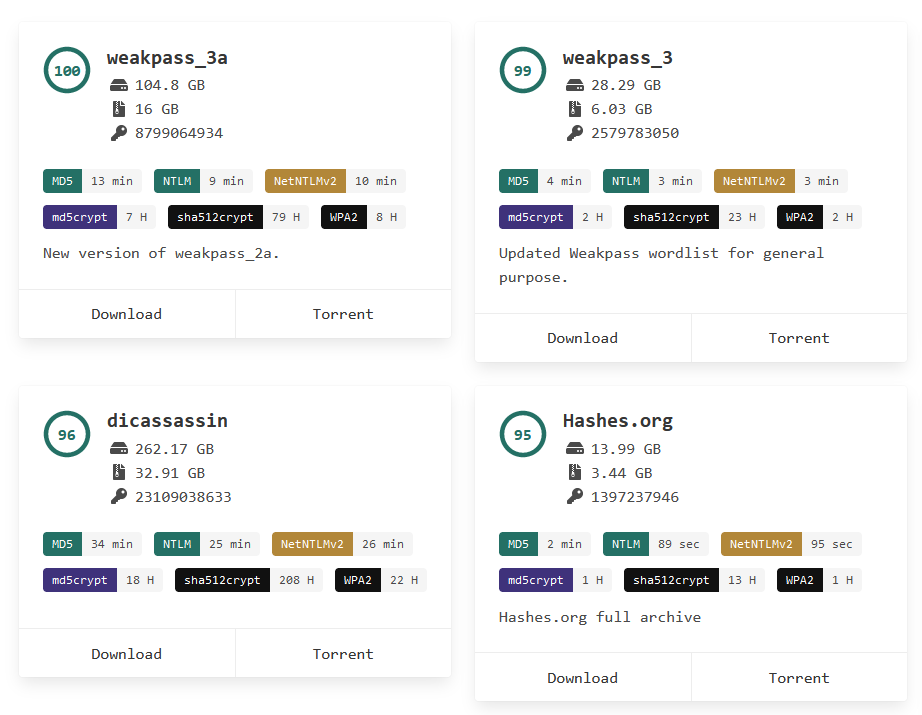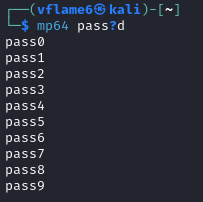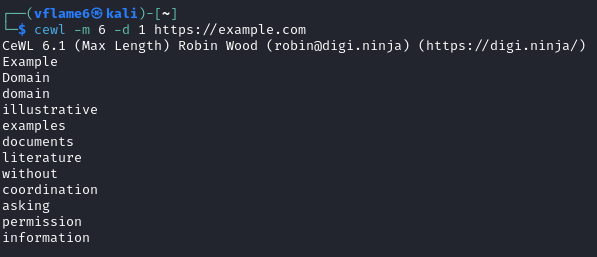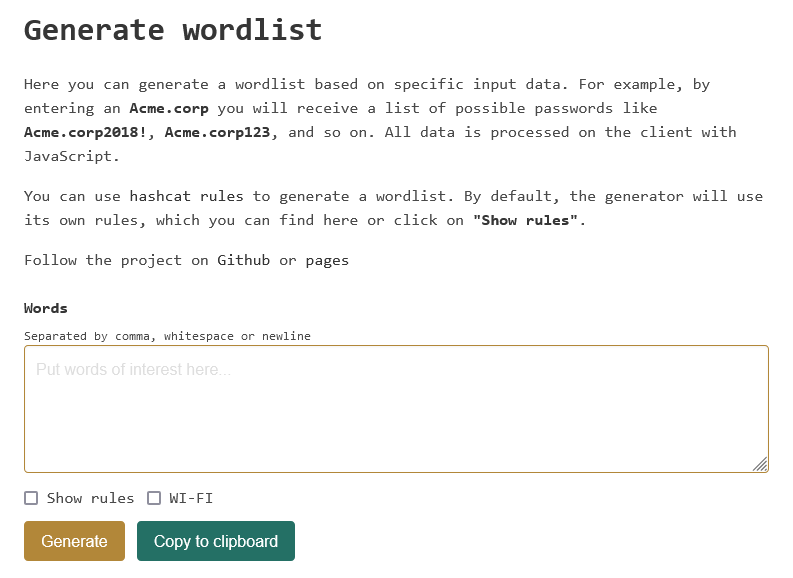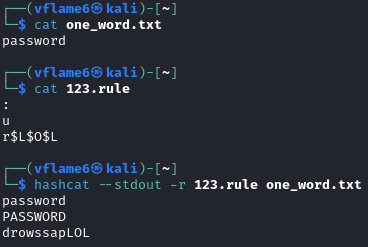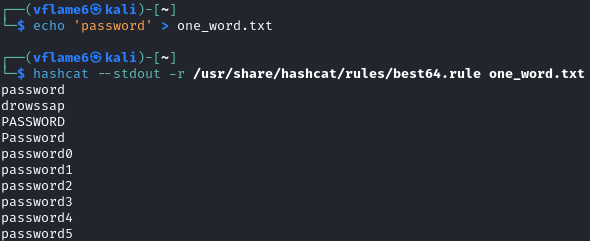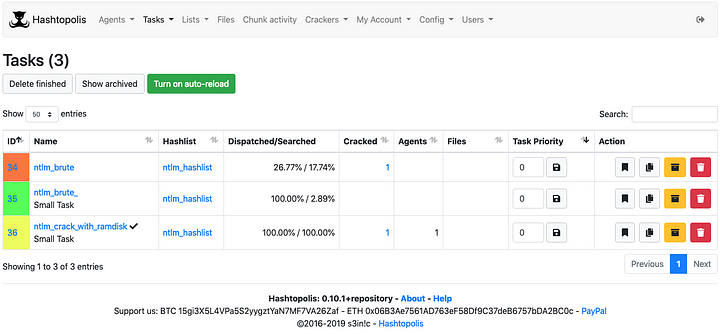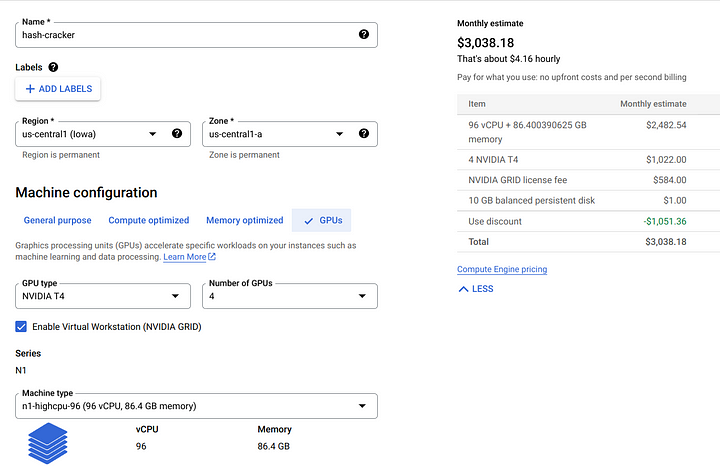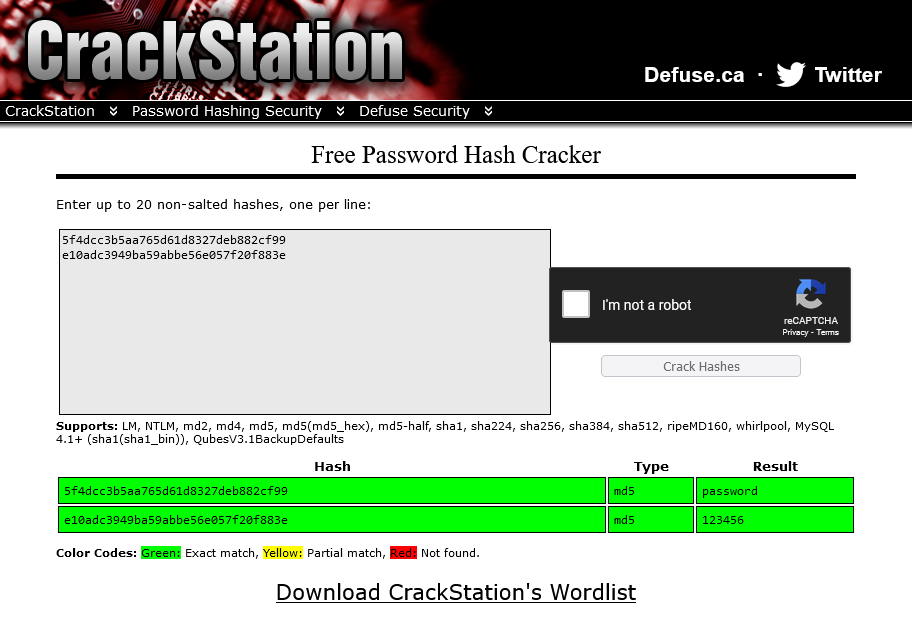Optimize Hash Cracking
Introduction
Hi! In this post I want we will explore some ways to optimize hash cracking. We can do it in many ways, for example by optimizing our cracking algorithms or improving hardware part. Our first questions are how many time do we have to crack the hashes and what type the hashes are? Answers for these quiestions help us choose the right technique and hardware sets. Let’s explore our possibilities with exaples.
It is useful in real penetration tests/red teams to try to optimize long processes, like password hashes cracking, because they are very time-consuming. And the time is very important in, for example, 2 week projects, when you don’t have enough time or enough CPUs/GPUs to brute-force all possible 8-9-10-characters with special symbols.
Creating Dictionary Masks
The first way to optimize brute-force attacks is to think about users of the target systems. The target may invole its own password policy with complexity and expiration requirements. And we can use this information to find a way to attack the passwords. Real users are always trying to make complex things simplier, and we can find patterns of matching-criteria passwords in victim’s systems.
Especially this is working when the target has too strong password rotation policy. For example, users must change their password at least one time in 30-60-90 days. The users will just start rotate their favorite 3-4-5 password combinations to make their work comfortable. Nowadays, even Microsoft recommends against password rotation policies.
For example, target’s password policy requires at least one uppercase character and 1 digit. It is common to see passwords with first uppercase letter several lowercase letters and digit or digits at the end of string. So, we can optimize our brute-force to set the first letter to uppercase and lowercase/digits at the end of the string. Our theory is to get the passwords like Orange66 or Abcdefg0.
We will use hashcat mask model here. 1 character in the mask sets by using ?num syntax. The num is set with characters. Time to crack is computed with cracking speed of 100 MHs per second.
| Characters | Length | Mask | Possible passwords | Time to crack |
|---|---|---|---|---|
| 1 - Uppercase, lowercase, digits | 8 | ?1?1?1?1?1?1?1?1 | 62x62x62x62x62x62x62x62 = 218 340 105 584 896 | 25.3 days |
| 1 - uppercase; 2 - lowercase; 3 - lowercase, digits | 8 | ?1?2?2?2?2?2?3?3 | 26x26x26x26x26x26x10x10 = 30 891 577 600 | 5.2 minutes |
Sometimes time economy is incredible. This theory could save us a lot of time if it worked. Let’s
Hashcat
Hashcat mask attack documentation
Mask attack with specified combinations:
1
hashcat -m 1000 -a 3 -1 ?u -2 ?l -3 ?l?d hashes.ntlm ?1?2?2?2?2?2?3?3
You can even create a file with various types of masks and then use the file in Hashcat. You can see an example below.
The general format of 1 single line in the .hcmask file is as follows:
1
[?1,][?2,][?3,][?4,]mask
Example file example.hcmask:
1
2
3
4
?u,?l,?l?d,?1?2?2?2?3?3
?l,?u,?u?d,?1?2?2?2?3?3?3
?l,?l,?u?d,?1?2?2?2?3?3?3
?d?l,?1?1?1?1?1?1?1?1
Mask attack with mask file:
1
hashcat -m 1000 -a 3 hashes.ntlm example.hcmask
JohnTheRipper
John The Ripper MASK documentation
Mask attack with pre-difened charset ?a - full ‘printable’ ASCII.
1
john --format=raw-md5 --mask='?a?a?a?a?a?a?a' hash.txt
Using Wordlists
Sometimes we have to do a dictionary-based attack, and the most improtrant thing here is to find, choose or generate the right dictionary. Then, we can improve our wordlists to make them more effective, or make them even bigger by using rules or combining them with masks.
Find Wordlists
There are some online resources on the Internet with collections of wordlists, which can be used to hash cracking. One popular website is WEAKPASS’s wordlists. It contains an all-in-one wordlist with almost 330 gigabytes (!) of data with 28 330 702 856 words.
Generate Wordlists
Generate from masks
We can use JohnTheRipper with --stdout option or Hashcat’s maskprocessor to generate a wordlist with specified mask.
1
2
3
4
5
6
# JohnTheRipper
john --mask='?d?d?d?d' --stdout
john --mask='8905143?d?d?d?d' --stdout > beeline.txt
# maskprocessor
mp64 pass?d
Parse websites
It is possible to use any website to generate a wordlists. For example, we can generate a dictionary by using words from target’s website.
In this medium article by @woFF author coded a Python script to get text from URLs with specified search parameters from Google Search API. It makes a search via Google Custom Search JSON API, retrives 100 result’s URLs, visits the URLs and extracts the text from them.
There is an automated tool created by Robin Wood. CeWL - Custom Word List generator is a ruby app which spiders a given URL to a specified depth, optionally following external links, and returns a list of words which can then be used for password crackers.
Example usage:
1
2
3
4
# -m - min word length (default: 3)
# -d - depth to spider to (default: 2)
# -w - write output to file
cewl -m 6 -d 1 -w https://example.com
Online generators
WEAKPASS has its own online password generator. It can generate a wordlist based on specific input data. For example, by entering an Acme.corp you will receive a list of possible passwords like Acme.corp2018!, Acme.corp123, and so on. All data is processed on the client with JavaScript.
AI based generators
After the Large Language Models (LLMs) boom in 2022, researchers started explore ways to use LLMs in security practice. In current topic it is possible to use them to generate meaningful custom wordlists using tools like ChatGPT.
There are some tools already built like meaningful-passwords GitHub repository with blog post on Leafcloud which generates passwords based on the meanings of a list of words using word vectors.
Also, we can train our own AIs to generate meaningful passwords. There is an ai-passwords GitHub repository by rarecoil, which is a collection of password lists in which he has trained various deep learning algorithms to try to come up with passwords.
This blog post on arsTECHNICA describes the power of PassGAN tool. PassGAN uses a Generative Adversarial Network (GAN) to autonomously learn the distribution of real passwords from actual password leaks, and to generate high-quality password guesses. The tool was introduced in 2017 and was really hyped by the community. You can find the research here and the tool in GitHub repository.
Improve Wordlists
There are ways to improve wordlists, when we have founded or generated a base dictionary for our attack.
The Hashcat’s attacks names and examples are used here. Our wordlists can be combined with some type of rules, for example, we can use leetspeak (l33tsp3@k) to make a new type of passwords in our wordlist, this attack is called a Rule-based attack. Also, we can combine the initial wordlist with mask described above to generate a new set of variants, this is called a Hybrid attack. And we can combine 2 wordlists together, which is called a Combinator attack.
Combinator attack
Hashcat’s combinator attack documentation
In the combinator attack built into hashcat (-a 1), two dictionaries are “combined” - each word of a dictionary is appended to each word in another dictionary.
1
./hashcat -m 0 -a 1 hash.txt dict1.txt dict2.txt
Hybrid attack
Hashcat’s hybrid attack documentation
For example if your example.dict contains:
1
2
password
hello
The configuration:
1
hashcat -a 6 example.dict ?d?d?d?d
Generates the following password candidates:
1
2
3
4
5
6
7
8
9
10
11
12
13
14
password0000
password0001
password0002
.
.
.
password9999
hello0000
hello0001
hello0002
.
.
.
hello9999
It also works on the opposite side!
1
hashcat -a 7 ?d?d?d?d example.dict
Rule-based attack
Hashcat’s rule-based attack documentation
Here we explore some simple rules for examples. You can find a full list of functions in the documentation linked above. It is possible to combine them to make cool combinations.
Contents of 123.rule file:
1
2
3
:
u
r$L$O$L
The rules used here are:
:for do nothing (passthrough)ufor uppercase all lettersrfor reverse entire word$Xfor append character X to end
Let’s see what how hashcat processes the rules by using a simple word password. We can check it with hashcat’s --stdout flag.
1
hashcat --stdout -r 123.rule one_word.txt
We can use our rule to crack the hash with command below:
1
hashcat -m 0 -a 0 -r 123.rule hash.txt wordlist.txt
There are some pre-build hashcat rules coming with hashcat’s installation. They contain useful basic mutations for words in dictionary. In Kali you can find them in /usr/share/hashcat/rules/. Let’s try to use one on one simple word password.
Distributed Cracking
It is possible to parallel our hash cracking tasks to several computers. This way can help us when we have access to several machines. The idea is to create a client-server model in hash cracking task. So, we have an administrative center, which computes parts of computed hashes numbers and distributes them, and cracking agents, which receives their parts and computes hashes.
An example of such tool is Hastopolis server Hashtopolis is a multi-platform client-server tool for distributing hashcat tasks to multiple computers. The main goals for Hashtopolis’s development are portability, robustness, multi-user support, and multiple groups management. In this Medium blog post by Tomas Savenas you can find an example of it’s usage.
The image below shows the example of hashtopolis administrative tasks page. Image source
There are some links to other tools which can be used in distributed cracking below:
- Fitcrack. Fitcrack is a BOINC-based hashcat-powered distributed password cracking system.
- CrackLord. CrackLord is a system designed to provide a scalable, pluggable, and distributed system for both password cracking as well as any other jobs needing lots of computing resources.
- Hashview. Hashview is a tool for security professionals to help organize and automate the repetitious tasks related to password cracking.
Cloud Computing
Cloud Computing services are really great in power and availability, but they can be really expensive, especially with hard computing tasks like hash cracking. They are useful, when you don’t want to make and maintain your own cracking rig.
Usage of Cloud Computing is always makes you think about your budget and if it is worth it. The clouds are very powerful in computing tasks and can be used in distributed hash cracks. But also clouds can make you “burn your money” for useless computing, so be very careful with them. There are a lot of situations, when operators just have forgot to stop their cloud and then got charged for big amounts of money.
It is really worth to plan and create a scripting for shutdown. It can be just a Bash script to shutdown your cloud machine for cost improvement.
Amazon Web Services
Amazon Web Services (AWS) with their GPUs configurations can be used in our hash cracking. AWSSEVNX made a step-by-step video guide to setup a powerful hash cracking virtual machine. Amazon EC2 P3 instances are used in the video.
There is a ec2hashcat GitHub repository made to to automate the process of password cracking on the AWS Cloud using GPU Instances. It handles the uploading/downloading of files to/from S3/EC2, starting/stopping of instances and running cudaHashcat. The repository was archieved, but there are some forks for it.
Google Cloud Platform
Google Cloud Platform (GCP) has its own Cloud GPUs service. You can check the pricing at GCP gpus-pricing page. Kacper Bąk described GCP usage with Hashcat for hash cracking purpose at his Medium blog post. When payment is done, the configured machine can be accessed by SSH, or right in browser with https://ssh.cloud.google.com/....
The image below is an example machine configuration for hash cracking. Image source.
vast.ai
You can rent a server with GPUs on vast.ai. It is a Global GPU Market with a low-cost cloud GPU rental. We can use it to buy GPU rigs for our hash cracking needs. Price for RTX 4090 is $0.376 per hour. It is not necessary to rent the most expensive/powerful rigs, but it’s depends on your tasks.
Combine with Distributed Cracking
The combinations of our computing resources and cloud computing can be used with Distributed Cracking . This Medium blog post by Nikita Guliaev shows a step-by-step guide to use vast.ai with Hashtopolis tool for distributed cloud computing to crack the hashes.
Prerequisites for the attack are:
- vast.ai account with enough money to buy GPUs. They will be used as agents to our Hastopolis server.
- Linux server with Internet access to create Hashtopolis server.
The author also created a docker image for hashtopolis agents, which can be pulled and used for GPUs agents. This makes the usage of distributed cracking as simple as possible. To connect an agent, the GPU server just have to execute 2 command at startup.
1
2
cd agent-python
python3 hashtopolis.zip --url server_api --voucher voucher_id
Online Crackers and Databases
You can delegate the hash cracking to an outsource by using online resources. There are just free databases like CrackStaion, which uses massive pre-computed lookup tables to crack password hashes and paid Cloud Password Recovery Services like OnlineHashCrack, which do the cracking in real time for money.
Conclusion
In this post we explored the ways to improve our hash cracking process. As we can see, there are many ways from improving our wordlists to improving our hardware and distribute the tasks. These ways can be combined all together to achieve great success/costs performance.
I would like to refer to a great Hash Crack - Password Cracking Manual book. It contains ways to extract hashes form various systems, hash cracking fundamentals and advanced tips to upgrade your hash cracking experience. I strongly recommend read this book.
Thank you for reading, I hope it was useful for you ❤️
